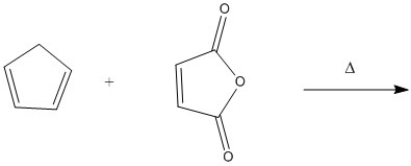Correct Answer

verified
Correct Answer
verified
Essay
When 3-bromo-1-methylcyclohexene is heated in a good ionizing solvent, reactions occur through a carbocation intermediate. Draw all reasonable resonance contributors of this cation and indicate which is the major contributor.
Correct Answer

verified
Correct Answer
verified
Essay
Draw the most stable conformation of (2Z,4E)-2,4-hexadiene.
Correct Answer

verified
Correct Answer
verified
Essay
Provide the structure of the major organic product in the following reaction. 
Correct Answer

verified
Correct Answer
verified
Multiple Choice
What is the major organic product which results when cycloheptene is irradiated in the presence of N-bromosuccinimide?
A) 1-bromocycloheptene
B) 2-bromocycloheptene
C) 1,2-dibromocycloheptane
D) 3-bromocycloheptene
E) 4-bromocycloheptene
G) A) and C)
Correct Answer

verified
Correct Answer
verified
Essay
Draw the major organic product that results from the intramolecular Diels-Alder reaction. 
Correct Answer

verified
Correct Answer
verified
Multiple Choice
What descriptive term is applied to the type of diene represented by 1,5-octadiene?
A) conjugated diene
B) cumulated diene
C) isolated diene
D) alkynyl diene
E) none of the above
G) None of the above
Correct Answer

verified
Correct Answer
verified
Essay
Dicylopentadiene results when cyclopentadiene reacts with itself in a Diels-Alder reaction. Provide the structure of dicyclopentadiene. Pay particular attention to stereochemical detail.
Correct Answer

verified
Correct Answer
verified
Essay
Assuming kinetic conditions, draw the major product of the reaction below. Include correct stereochemistry. 
Correct Answer

verified
Correct Answer
verified
Multiple Choice
How many nodes, other than the node coincident with the molecular plane, are present in the HOMO of 1,3,5-hexatriene?
A) 1
B) 2
C) 3
D) 4
E) 5
G) D) and E)
Correct Answer

verified
Correct Answer
verified
Multiple Choice
Which of the following compounds is the most reactive dienophile in a Diels-Alder reaction with 1,3-butadiene?
A) CH2
![]()
CHOCH3
B) CH2
![]()
CHCHO
C) CH3CH ![]() CHCH3
CHCH3
D) (CH3) 2C ![]() CH2
CH2
E) CH2
![]()
CH2
G) A) and B)
Correct Answer

verified
Correct Answer
verified
Essay
What characterizes a pericyclic reaction?
Correct Answer

verified
Pericyclic reactions involve c...View Answer
Show Answer
Correct Answer
verified
View Answer
Short Answer
Which has a λmax in its UV spectrum at a longer wavelength, 2,4-hexadiene, 1,4-hexadiene, or 1,5-hexadiene?
Correct Answer

verified
Correct Answer
verified
Essay
Give a representation of the highest occupied π MO of 1,3-butadiene in its ground state.
Correct Answer

verified
Correct Answer
verified
Short Answer
For what does the acronym HOMO stand?
Correct Answer

verified
highest oc...View Answer
Show Answer
Correct Answer
verified
View Answer
Multiple Choice
Which sequence correctly ranks the following conjugated systems in order of increasing UV λmax absorption values? 
A) 1 < 2 < 3
B) 2 < 1 < 3
C) 2 < 3 < 1
D) 3 < 1 < 2
E) 3 < 2 < 1
G) B) and E)
Correct Answer

verified
Correct Answer
verified
Essay
Provide the structure of the major organic product in the following reaction. 
Correct Answer

verified
Correct Answer
verified
Multiple Choice
How many nodes, other than the node coincident with the molecular plane, are present in the LUMO of 1,3,5-hexatriene?
A) 1
B) 2
C) 3
D) 4
E) 5
G) D) and E)
Correct Answer

verified
Correct Answer
verified
Essay
Using resonance structures, explain the regiochemistry observed in this reaction: 
Correct Answer

verified
Correct Answer
verified
Multiple Choice
Which of the following terms best describes a Diels-Alder reaction?
A) a [4+2] cycloaddition
B) a [2+2] cycloaddition
C) a sigmatropic rearrangement
D) a 1,3-dipolar cycloaddition
E) a substitution reaction
G) A) and D)
Correct Answer

verified
Correct Answer
verified
Showing 81 - 100 of 130
Related Exams